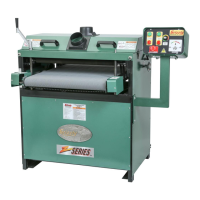Model G1066R/Z/G1079R (Mfd. Since 02/11)
-39-
Operation
Symptom Possible Cause Possible Solution
Machine slows
when sanding;
makes squealing
noise on start-up.
1. Belt(s) loose or worn. 1. Tension/replace belt(s) (Page 45).
Grinding,
screeching, or
rubbing noise from
sanding drums.
1. Drum scraping on dust scoop.
2. Drum bearings need grease.
3. Drum bearings worn.
1. Adjust dust scoop so it does not contact drum
(Page 44).
2. Grease drum bearings (Page 29).
3. Replace drum bearings (Page 47).
Machine lacks
power; drums stop
turning under load.
1. Too much pressure on sanding drum.
2. Belt(s) loose or worn.
1. Lower conveyor table (Page 31).
2. Tension/replace belts (Page 45).
Conveyor belt slips
under load.
1. Conveyor belt loose or worn.
2. Workpiece too heavy.
1. Tension/replace conveyor belt (Page 43).
2. Use lighter workpiece.
Workpiece pulls
to one side during
sanding operations.
1. Sanding drum(s) not perpendicular to feed
direction.
2. Sanding drum(s) not parallel with table.
1. Adjust sanding drum(s) perpendicular to feed
direction (Page 40).
2. Adjust sanding drum(s) parallel to table (Page 41).
Workpiece kicks out
of sander.
1. Not enough pressure from pressure rollers.
2. Sanding drum(s) not properly aligned.
1. Lower pressure rollers (Page 42).
2. Adjust sanding drum(s) alignment (Page 40).
Excessive snipe. 1. Lack of outfeed support.
2. Too much pressure from pressure rollers.
3. Too much pressure from rear pressure
roller.
1. Set up outfeed table or have someone catch
workpiece as it comes out.
2. Raise pressure rollers (Page 42).
3. Raise rear pressure roller (Page 42).
Sanding grains
easily rub off roll.
1. Sandpaper roll has been stored in an
incorrect environment.
2. Sandpaper roll has been smashed or
folded.
1. Replace damaged sandpaper roll (Pages 33–34).
Store sanding belt in a cool, dry area.
2. Replace damaged sandpaper roll (Pages 33–34).
Do not bend or fold sanding belt.
Sandpaper comes
off drum or is loose.
1. Sandpaper roll not properly wrapped
around drum.
2. Sandpaper roll not correct size.
3. Torn or damaged sandpaper.
4. Sandpaper not tightened or fastened
correctly.
5. Sanding drum not parallel with table.
1. Re-install sandpaper roll (Pages 33–34).
2. Cut sandpaper roll to correct dimensions
(Pages 33–34).
3. Replace sandpaper roll (Pages 33–34).
4. Re-install sandpaper roll (Pages 33–34).
5. Adjust sanding drum parallel to table (Page 40).
Glazed sanding
surface.
1. Workpiece has excessive moisture.
2. Workpiece has high amount of residue.
3. Sandpaper roll loaded up.
4. Sandpaper roll worn or damaged.
1. Only sand dry stock with moisture content below
20%.
2. Use different stock, or accept characteristics
of stock and plan to clean/replace sanding belt
frequently.
3. Clean sandpaper roll (Page 30).
4. Replace sandpaper roll (Pages 33–34).
Burn marks on
workpiece.
1. Using too fine of sanding grit for depth of
cut.
2. Sandpaper roll loaded up
3. Feed rate too slow (G1066Z).
4. Sandpaper roll not properly wrapped
around drum.
5. Sandpaper roll worn or damaged.
1. Use coarser grit sandpaper (Page 29) or decrease
depth of cut (Page 31).
2. Clean sandpaper roll (Page 30).
3. Increase feed rate (G1066Z) (Page 32).
4. Re-install sandpaper roll (Pages 33–34).
5. Replace sandpaper roll (Pages 33–34).

